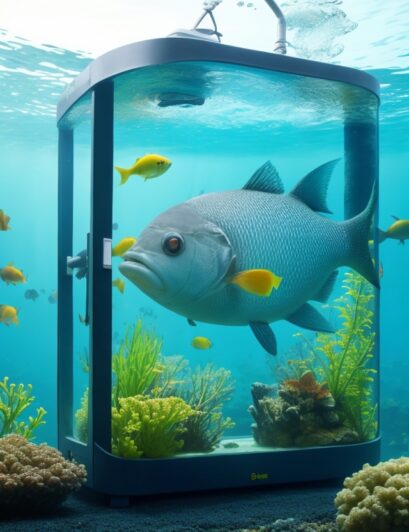Fish Marketing Trends in India: The Indian fish market is one of the largest in the world, with a production of over 19 million tonnes in 2022. The market is expected to grow at a CAGR of 8.81% over the next five years, driven by factors such as increasing urbanization, rising disposable incomes, and growing awareness of the health benefits of fish.
Fish Marketing Trends in India
Fish marketing trends in India are influenced by various factors, such as the rising consumer awareness about the nutritional benefits of fish, the advancements in aquaculture technology, the government initiatives to promote sustainable fisheries, the expansion of cold-chain logistics, and the increasing demand for varied aquatic species. According to a report by IMARC Group, the Indian fish market size reached 20.7 million tons in 2023 and is expected to reach 41.4 million tons by 2032, growing at a CAGR of 7.8% during 2024-2032. The report also provides an analysis of the market based on fish type, product type, distribution channel, sector, and state. Some of the major challenges faced by the fish marketing system in India are the high perishability of fish, the lack of adequate infrastructure and facilities, the presence of multiple intermediaries, and the low share of fisherman in the consumer’s rupee. To overcome these challenges, some of the possible solutions are the improvement of post-harvest management practices, the initiation of quality certification programs, the development of domestic storage and cold chain infrastructure, and the education of fishers and consumers about responsible fishing practices. ‘Fish Marketing Trends’
The fish marketing trends in India are changing rapidly, driven by a number of factors, including:
- Growing demand for fish: The Indian population is becoming increasingly affluent and health-conscious, leading to a growing demand for fish. Fish is a good source of protein and other essential nutrients, and it is also low in saturated fat.
- Increasing availability of fish: The aquaculture industry in India is growing rapidly, leading to an increasing availability of fish. Aquaculture is the farming of fish, and it is a more sustainable way to produce fish than wild-caught fish.
- Changing consumer preferences: Consumers are becoming more demanding, and they are looking for high-quality, fresh fish that is conveniently available.
- Growth of e-commerce: The growth of e-commerce is also having an impact on the fish marketing landscape. Consumers are increasingly using online platforms to purchase fish.
Some of the key trends in fish marketing in India include:
- Increased focus on quality: There is a growing focus on the quality of fish, and consumers are demanding fresh, high-quality fish.
- Convenience: Consumers are looking for convenient ways to purchase fish, and there is a growing demand for online and home delivery of fish.
- Sustainable sourcing: There is a growing awareness of the importance of sustainable fishing, and consumers are demanding fish that is sourced sustainably.
- Innovation: The fish marketing industry is constantly innovating, and there are a number of new trends emerging, such as the use of blockchain technology to track the provenance of fish.
The fish marketing trends in India are expected to continue to change in the coming years, driven by the factors mentioned above. The industry is likely to become more competitive, and there will be a growing focus on quality, convenience, and sustainability.
Here are some of the specific fish marketing trends that are expected to gain traction in India in the coming years:
- Growth of the online fish market: The online fish market is expected to grow rapidly in India, as consumers become more comfortable with buying fish online. Online platforms offer a number of advantages, such as convenience, variety, and competitive prices.
- Increased focus on value-added fish products: There is a growing demand for value-added fish products, such as ready-to-cook fish, fish fillets, and fish snacks. These products are convenient and easy to prepare, and they appeal to consumers who are looking for healthy and convenient meal options.
- Rise of the sustainable fish market: There is a growing awareness of the importance of sustainable fishing, and consumers are demanding fish that is sourced sustainably. This is leading to the growth of the sustainable fish market, which offers fish that has been caught or farmed in a way that minimizes its impact on the environment.
- Innovation in fish packaging: There is a growing focus on innovative fish packaging that can help to preserve the quality of fish and extend its shelf life. This is important for ensuring that fish is fresh and safe to eat.
The fish marketing trends in India are constantly evolving, and it is important for businesses to stay up-to-date on the latest trends in order to remain competitive. By understanding the key trends, businesses can develop strategies to meet the needs of consumers and grow their business.
In India the up-gradation of wholesale and retail fish markets and establishment of quality outlets through the-
Modernization of wholesale fish markets
Cold chains of varying levels
Hygienic Retail outlets
Funds for design of outlets and Technology up-gradation
Better quality fish to the consumers
Stability in prices
Reduction of post-harvest losses
Infrastructure for Fish Marketing
The wholesale fish markets are generally traditional unorganized, inadequate facilities for handling and storage of fish production
The retail markets are receiving poor quality fish due to improper handling, storage and transportation.
Lack of adequate cold chain right from the primary producer to the consumer in the system, at different locations to control the spoilage

An old Fish Market in Amalapuram, A.P.
 |
| New Fish Market in Amalapuram, A.P. |
NFDB’s Intervention
NFDB to develop domestic marketing with significant contribution in reducing post harvest losses, enhance revenue and also improve the hygienic and sanitary conditions in fish markets and efficient retail marketing network.
Wholesale Marketing
To improve wholesale marketing, basic requirements is to be needed:-
- Development of roads
- Connectivity with other retail and landing centres and interior markets
- Large scale storage facilities, cold storage facilities, there is a provision for ice, clean water, communication facilities and waste management systems etc.
- Hygiene and sanitation on par with international standards
Retail Marketing
To improve retail marketing, basic requirements is to be needed:-
- A chain of cold storage right from the primary producer to the consumer, at different locations to control the spoilage.
- Hygienic large stalls and platforms for trading, potable water facility, ice facility, roofing and flooring, proper civil structure.
- Facility for display of products, suitable equipment for washing, weighing, communication etc.
 |
| Domestic Old markets |







